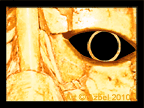
Greetings
The Mayanist
El Paso Museum of History to host
Mystery of the Mayan Medallion Exhibition
October 13 – January 15
Six separate areas anchor the Mystery of the Mayan Medallion exhibit. Three walk-in architectural elements; the Tomb, the Observatory, and the Temple all appear partially excavated. Three additional field stations are housed in tents; Archaeology, Astromathematics, and Biology. Each contains several activities. Bussing and admission expenses are available to school groups.
Moey created two interactive pieces to help bring to life this traveling children's educational exhibit about Mayan history, archeology, biology and even astromathematics. Students are asked to uncover the mystery of an archealogical dig site to help find a priceless treasure.

Children were warned that certain dangers lurked in the exhibition. In one wall, in which the treasure may have been hidden, a surprise awaited: a simulated "bite" from a freya spider, common to Central and South America. The "bite" was actually a Moey-built burst of air from a silent pneumatic pump that was connected to an LED that simultaneously revealed information about the freya.
At the end of the exhibit, the hidden treasure is found only if the students have paid attention to the Mayan glyphs throughout the exhibit. Students approach a wall that features a series of Mayan glyphs. When students touch the correct four glyphs, the treasure is revealed. Moey built the custom sensors and electronics to make the archaeological achievement a convincingly real experience for the children.
Interpretation and design by Argyle Design, Inc.





















































































































































































































